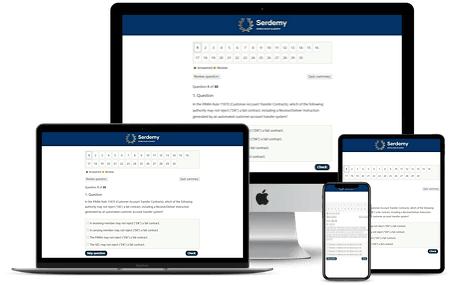Quiz-summary
0 of 30 questions completed
Questions:
- 1
- 2
- 3
- 4
- 5
- 6
- 7
- 8
- 9
- 10
- 11
- 12
- 13
- 14
- 15
- 16
- 17
- 18
- 19
- 20
- 21
- 22
- 23
- 24
- 25
- 26
- 27
- 28
- 29
- 30
Information
Premium Practice Questions
You have already completed the quiz before. Hence you can not start it again.
Quiz is loading...
You must sign in or sign up to start the quiz.
You have to finish following quiz, to start this quiz:
Results
0 of 30 questions answered correctly
Your time:
Time has elapsed
Categories
- Not categorized 0%
- 1
- 2
- 3
- 4
- 5
- 6
- 7
- 8
- 9
- 10
- 11
- 12
- 13
- 14
- 15
- 16
- 17
- 18
- 19
- 20
- 21
- 22
- 23
- 24
- 25
- 26
- 27
- 28
- 29
- 30
- Answered
- Review
-
Question 1 of 30
1. Question
A principal at Apex Capital Partners, a dealer-manager, is reviewing the proposed compensation structure for the Keystone Property Trust, a new public, non-listed real estate DPP. The offering seeks to raise \(\$20,000,000\) in gross proceeds. The offering document outlines the following fees and expenses: – Sales commission to soliciting dealers: \(8\%\) of gross proceeds – Dealer-manager fee: \(1.5\%\) of gross proceeds – Fees to a third-party wholesaling firm: \(\$150,000\) – Reimbursement to the dealer-manager for bona fide due diligence expenses: \(\$75,000\) – Issuer’s legal and accounting fees: \(\$400,000\) – Printing and filing costs: \(\$100,000\) – A sponsor-funded “top producer educational conference” in Hawaii for representatives of the selling group, with a determined value of \(\$250,000\) Based on this information, which of the following represents the most accurate assessment of this compensation structure under FINRA Rule 2310?
Correct
Under FINRA Rule 2310, total underwriting compensation for a public direct participation program offering is limited to 10% of the gross offering proceeds. Separately, total organization and offering expenses, which include underwriting compensation plus other issuer expenses, are limited to 15% of the gross proceeds. It is critical to analyze the components of compensation to ensure compliance with both limits. First, calculate the maximum allowable underwriting compensation. The gross offering proceeds are \(\$20,000,000\). The 10% limit is \(0.10 \times \$20,000,000 = \$2,000,000\). Next, identify and sum all items that constitute underwriting compensation. These include: 1. Sales commissions: \(8\%\) of \(\$20,000,000\) equals \(\$1,600,000\). 2. Dealer-manager fee: \(1.5\%\) of \(\$20,000,000\) equals \(\$300,000\). 3. Wholesaler fees: \(\$150,000\). 4. Reimbursement for due diligence expenses: \(\$75,000\). 5. Non-cash compensation (the value of the “educational conference”): \(\$250,000\). The total underwriting compensation is the sum of these items: \(\$1,600,000 + \$300,000 + \$150,000 + \$75,000 + \$250,000 = \$2,375,000\). Comparing the total calculated underwriting compensation to the limit reveals a violation. The total of \(\$2,375,000\) exceeds the maximum allowable \(\$2,000,000\) under the 10% rule. Although the issuer’s legal, accounting, printing, and filing fees are considered organization and offering expenses, they are not part of the underwriting compensation calculation. Even if the total O&O expenses are within the 15% limit, the 10% sub-limit for underwriting compensation has been breached. Non-cash compensation, such as incentive trips, must be valued and included in this 10% calculation.
Incorrect
Under FINRA Rule 2310, total underwriting compensation for a public direct participation program offering is limited to 10% of the gross offering proceeds. Separately, total organization and offering expenses, which include underwriting compensation plus other issuer expenses, are limited to 15% of the gross proceeds. It is critical to analyze the components of compensation to ensure compliance with both limits. First, calculate the maximum allowable underwriting compensation. The gross offering proceeds are \(\$20,000,000\). The 10% limit is \(0.10 \times \$20,000,000 = \$2,000,000\). Next, identify and sum all items that constitute underwriting compensation. These include: 1. Sales commissions: \(8\%\) of \(\$20,000,000\) equals \(\$1,600,000\). 2. Dealer-manager fee: \(1.5\%\) of \(\$20,000,000\) equals \(\$300,000\). 3. Wholesaler fees: \(\$150,000\). 4. Reimbursement for due diligence expenses: \(\$75,000\). 5. Non-cash compensation (the value of the “educational conference”): \(\$250,000\). The total underwriting compensation is the sum of these items: \(\$1,600,000 + \$300,000 + \$150,000 + \$75,000 + \$250,000 = \$2,375,000\). Comparing the total calculated underwriting compensation to the limit reveals a violation. The total of \(\$2,375,000\) exceeds the maximum allowable \(\$2,000,000\) under the 10% rule. Although the issuer’s legal, accounting, printing, and filing fees are considered organization and offering expenses, they are not part of the underwriting compensation calculation. Even if the total O&O expenses are within the 15% limit, the 10% sub-limit for underwriting compensation has been breached. Non-cash compensation, such as incentive trips, must be valued and included in this 10% calculation.
-
Question 2 of 30
2. Question
As the Direct Participation Program Principal for Apex Securities, Kenji is conducting a final review of the compensation structure for a new \(\$20,000,000\) public real estate limited partnership offering. The offering document details the following payments and reimbursements: – Selling commissions to soliciting dealers: \(\$1,600,000\) – Dealer-manager fee: \(\$300,000\) – Compensation to wholesalers: \(\$200,000\) – Bona fide due diligence expense reimbursement: \(\$60,000\) – Legal and accounting fees for the offering: \(\$450,000\) – Printing and filing fees: \(\$150,000\) – Sponsor’s acquisition fees for program properties: \(\$1,000,000\) Based on Kenji’s analysis under FINRA Rule 2310, which of the following conclusions is accurate regarding the offering’s compensation structure?
Correct
The calculation begins by determining the total underwriting compensation based on the figures provided in the offering. Underwriting compensation under FINRA Rule 2310 includes selling commissions, dealer-manager fees, wholesaler compensation, and bona fide due diligence expense reimbursements. The sum of these items is \(\$1,600,000 + \$300,000 + \$200,000 + \$60,000 = \$2,160,000\). Next, the maximum allowable underwriting compensation is calculated. This is limited to \(10\%\) of the gross offering proceeds, plus up to an additional \(0.5\%\) for bona fide due diligence expenses (though the syllabus notes \(0.3\%\), the result is the same in this case as the main \(10\%\) limit is breached). The \(10\%\) limit on the \(\$20,000,000\) offering is \(\$2,000,000\). The additional allowable amount for due diligence is \(0.5\%\) of \(\$20,000,000\), which is \(\$100,000\). The actual due diligence expense is \(\$60,000\), which is less than this cap. Therefore, the total maximum allowable underwriting compensation is the \(10\%\) limit plus the actual due diligence reimbursement: \(\$2,000,000 + \$60,000 = \$2,060,000\). The calculated underwriting compensation of \(\$2,160,000\) exceeds this limit by \(\$100,000\). Separately, the total organization and offering (O&O) expenses are calculated. These include all underwriting compensation plus other offering-related expenses like legal, accounting, printing, and filing fees. The sponsor’s acquisition fees are program operating costs, not O&O expenses. The total O&O expenses are \(\$2,160,000\) (total underwriting compensation) \(+ \$450,000\) (legal/accounting) \(+ \$150,000\) (printing/filing) \( = \$2,760,000\). The maximum allowable O&O expense is \(15\%\) of the gross offering proceeds, which is \(15\%\) of \(\$20,000,000\), or \(\$3,000,000\). The calculated total O&O expense of \(\$2,760,000\) is within this limit. However, because the separate underwriting compensation limit is violated, the entire compensation structure is non-compliant.
Incorrect
The calculation begins by determining the total underwriting compensation based on the figures provided in the offering. Underwriting compensation under FINRA Rule 2310 includes selling commissions, dealer-manager fees, wholesaler compensation, and bona fide due diligence expense reimbursements. The sum of these items is \(\$1,600,000 + \$300,000 + \$200,000 + \$60,000 = \$2,160,000\). Next, the maximum allowable underwriting compensation is calculated. This is limited to \(10\%\) of the gross offering proceeds, plus up to an additional \(0.5\%\) for bona fide due diligence expenses (though the syllabus notes \(0.3\%\), the result is the same in this case as the main \(10\%\) limit is breached). The \(10\%\) limit on the \(\$20,000,000\) offering is \(\$2,000,000\). The additional allowable amount for due diligence is \(0.5\%\) of \(\$20,000,000\), which is \(\$100,000\). The actual due diligence expense is \(\$60,000\), which is less than this cap. Therefore, the total maximum allowable underwriting compensation is the \(10\%\) limit plus the actual due diligence reimbursement: \(\$2,000,000 + \$60,000 = \$2,060,000\). The calculated underwriting compensation of \(\$2,160,000\) exceeds this limit by \(\$100,000\). Separately, the total organization and offering (O&O) expenses are calculated. These include all underwriting compensation plus other offering-related expenses like legal, accounting, printing, and filing fees. The sponsor’s acquisition fees are program operating costs, not O&O expenses. The total O&O expenses are \(\$2,160,000\) (total underwriting compensation) \(+ \$450,000\) (legal/accounting) \(+ \$150,000\) (printing/filing) \( = \$2,760,000\). The maximum allowable O&O expense is \(15\%\) of the gross offering proceeds, which is \(15\%\) of \(\$20,000,000\), or \(\$3,000,000\). The calculated total O&O expense of \(\$2,760,000\) is within this limit. However, because the separate underwriting compensation limit is violated, the entire compensation structure is non-compliant.
-
Question 3 of 30
3. Question
Alex, a registered representative at a broker-dealer that exclusively offers Direct Participation Programs, provides written notice to his supervising principal, Maria. The notice details his intent to help syndicate a private placement for a non-affiliated real estate development DPP, for which he will receive a finder’s fee. According to FINRA Rule 3280 concerning private securities transactions, what is the required course of action for Maria’s firm?
Correct
Under FINRA Rule 3280, when an associated person intends to participate in a private securities transaction for compensation, the employing member firm has specific and stringent obligations. Upon receiving written notice from the associated person, the firm is not merely acknowledging the activity. It must explicitly approve or disapprove the person’s participation. If the firm chooses to approve the transaction, it must then record the transaction on its own books and records. Furthermore, the firm must supervise the associated person’s participation in the transaction as if the transaction were being executed on behalf of the member firm itself. This means the full scope of the firm’s supervisory procedures, as outlined in rules like FINRA Rule 3110, would apply to the representative’s activities in the private transaction. This requirement is a critical distinction from private securities transactions conducted without compensation, where the firm’s obligation is to provide written acknowledgement and may impose conditions but is not required to record the transaction on its books or supervise it as its own. The involvement of compensation triggers a higher level of scrutiny and responsibility, effectively bringing the outside activity under the firm’s direct supervisory umbrella to protect investors and ensure compliance.
Incorrect
Under FINRA Rule 3280, when an associated person intends to participate in a private securities transaction for compensation, the employing member firm has specific and stringent obligations. Upon receiving written notice from the associated person, the firm is not merely acknowledging the activity. It must explicitly approve or disapprove the person’s participation. If the firm chooses to approve the transaction, it must then record the transaction on its own books and records. Furthermore, the firm must supervise the associated person’s participation in the transaction as if the transaction were being executed on behalf of the member firm itself. This means the full scope of the firm’s supervisory procedures, as outlined in rules like FINRA Rule 3110, would apply to the representative’s activities in the private transaction. This requirement is a critical distinction from private securities transactions conducted without compensation, where the firm’s obligation is to provide written acknowledgement and may impose conditions but is not required to record the transaction on its books or supervise it as its own. The involvement of compensation triggers a higher level of scrutiny and responsibility, effectively bringing the outside activity under the firm’s direct supervisory umbrella to protect investors and ensure compliance.
-
Question 4 of 30
4. Question
A principal at Apex Syndicators is reviewing the proposed compensation structure for a new public, non-listed real estate DPP. The offering seeks to raise $20,000,000 in gross proceeds. The proposed expense structure is as follows: 7% sales commission to the selling group, a 2% override fee to the dealer-manager, a fixed $150,000 fee for wholesaling services, a $50,000 reimbursement for bona fide due diligence expenses, and $500,000 for the issuer’s legal and accounting costs. Based on FINRA rules governing public DPP offerings, which statement accurately assesses the compliance of this compensation plan?
Correct
The calculation to determine compliance with FINRA rules for this Direct Participation Program (DPP) offering involves two main tests: the limit on underwriting compensation and the limit on total organization and offering (O&O) expenses. The gross offering proceeds are $20,000,000. First, calculate the total underwriting compensation. This includes all compensation paid to the broker-dealer and its affiliates for distributing the program. Sales commissions: \(0.07 \times \$20,000,000 = \$1,400,000\) Dealer-manager fee: \(0.02 \times \$20,000,000 = \$400,000\) Wholesaling fees (fixed): \(\$150,000\) Due diligence reimbursement: \(\$50,000\) Total Underwriting Compensation = \(\$1,400,000 + \$400,000 + \$150,000 + \$50,000 = \$2,000,000\) Next, test this against the FINRA limit. Underwriting compensation in a public DPP offering is limited to 10% of the gross offering proceeds. Limit: \(0.10 \times \$20,000,000 = \$2,000,000\) Since the calculated total underwriting compensation of $2,000,000 is equal to the $2,000,000 limit, this part of the structure is compliant. Second, calculate the total organization and offering (O&O) expenses. This includes all underwriting compensation plus the issuer’s own expenses related to the offering. Total Underwriting Compensation: \(\$2,000,000\) Issuer’s legal and accounting costs: \(\$500,000\) Total O&O Expenses = \(\$2,000,000 + \$500,000 = \$2,500,000\) Finally, test this against the FINRA limit. Total O&O expenses are limited to 15% of the gross offering proceeds. Limit: \(0.15 \times \$20,000,000 = \$3,000,000\) Since the calculated total O&O expenses of $2,500,000 are less than the $3,000,000 limit, this part of the structure is also compliant. Therefore, the entire compensation plan is compliant with FINRA rules. FINRA Rule 2310 and Rule 5110 establish the compensation limits for public offerings of direct participation programs. A critical distinction for a principal to understand is the two-tiered limit structure. The first tier is a 10 percent limit on total underwriting compensation, which is a broad category encompassing all forms of compensation received by member firms involved in the distribution. This includes not only direct sales commissions and dealer-manager fees but also reimbursements for expenses like due diligence and fees for wholesaling activities. All these items must be aggregated and measured against the gross proceeds of the offering. The second tier is a 15 percent limit on total organization and offering expenses. This is a more inclusive figure that starts with the total underwriting compensation and adds the issuer’s direct expenses, such as legal fees, accounting fees, and printing costs. Both of these percentage limits are calculated based on the gross dollar amount of securities sold, not the net amount received by the issuer. A principal must verify that both of these independent limits are met for an offering’s compensation structure to be deemed compliant.
Incorrect
The calculation to determine compliance with FINRA rules for this Direct Participation Program (DPP) offering involves two main tests: the limit on underwriting compensation and the limit on total organization and offering (O&O) expenses. The gross offering proceeds are $20,000,000. First, calculate the total underwriting compensation. This includes all compensation paid to the broker-dealer and its affiliates for distributing the program. Sales commissions: \(0.07 \times \$20,000,000 = \$1,400,000\) Dealer-manager fee: \(0.02 \times \$20,000,000 = \$400,000\) Wholesaling fees (fixed): \(\$150,000\) Due diligence reimbursement: \(\$50,000\) Total Underwriting Compensation = \(\$1,400,000 + \$400,000 + \$150,000 + \$50,000 = \$2,000,000\) Next, test this against the FINRA limit. Underwriting compensation in a public DPP offering is limited to 10% of the gross offering proceeds. Limit: \(0.10 \times \$20,000,000 = \$2,000,000\) Since the calculated total underwriting compensation of $2,000,000 is equal to the $2,000,000 limit, this part of the structure is compliant. Second, calculate the total organization and offering (O&O) expenses. This includes all underwriting compensation plus the issuer’s own expenses related to the offering. Total Underwriting Compensation: \(\$2,000,000\) Issuer’s legal and accounting costs: \(\$500,000\) Total O&O Expenses = \(\$2,000,000 + \$500,000 = \$2,500,000\) Finally, test this against the FINRA limit. Total O&O expenses are limited to 15% of the gross offering proceeds. Limit: \(0.15 \times \$20,000,000 = \$3,000,000\) Since the calculated total O&O expenses of $2,500,000 are less than the $3,000,000 limit, this part of the structure is also compliant. Therefore, the entire compensation plan is compliant with FINRA rules. FINRA Rule 2310 and Rule 5110 establish the compensation limits for public offerings of direct participation programs. A critical distinction for a principal to understand is the two-tiered limit structure. The first tier is a 10 percent limit on total underwriting compensation, which is a broad category encompassing all forms of compensation received by member firms involved in the distribution. This includes not only direct sales commissions and dealer-manager fees but also reimbursements for expenses like due diligence and fees for wholesaling activities. All these items must be aggregated and measured against the gross proceeds of the offering. The second tier is a 15 percent limit on total organization and offering expenses. This is a more inclusive figure that starts with the total underwriting compensation and adds the issuer’s direct expenses, such as legal fees, accounting fees, and printing costs. Both of these percentage limits are calculated based on the gross dollar amount of securities sold, not the net amount received by the issuer. A principal must verify that both of these independent limits are met for an offering’s compensation structure to be deemed compliant.
-
Question 5 of 30
5. Question
A principal at Apex Broker-Dealers is supervising the firm’s role as a dealer-manager for “Windward Real Estate Partners,” a DPP structured as a mini-max public offering. The offering requires a minimum of $5 million in subscriptions by June 30th to break escrow. As of June 29th, only $4.5 million has been raised from public investors. The program’s sponsor, an affiliate of a large property developer, proposes to have another one of its wholly-owned subsidiaries purchase the remaining $500,000 in units to meet the minimum. The sponsor provides a verbal assurance to the principal that the DPP will repurchase these units from the subsidiary within 90 days of the closing. From a regulatory standpoint, what is the most significant compliance failure the principal must prevent by rejecting the sponsor’s proposal?
Correct
The core issue is the violation of the terms of a contingent offering, specifically a mini-max offering. The analysis proceeds as follows: 1. Identify the offering type and its rules: The offering is a mini-max, which is a type of contingent offering governed by SEC Rule 10b-9 and SEC Rule 15c2-4. 2. Analyze the contingency: The offering requires $5 million in bona fide sales to public investors by a specific date to break escrow. 3. Evaluate the sponsor’s proposal: The sponsor suggests using an affiliated, non-public entity to purchase the shortfall with a pre-arranged agreement for the DPP to repurchase the units. 4. Determine the nature of the proposed transaction: This is not a bona fide, at-risk investment. It is a mechanism to artificially meet the minimum subscription level. 5. Apply SEC Rule 10b-9: This rule makes it a manipulative and deceptive device to represent an offering as contingent (e.g., mini-max) unless the offering is terminated and investor funds are promptly returned if the specified contingency is not fully satisfied. Using non-bona fide sales to close the offering creates a false impression that the contingency was met, which is a direct violation of this rule. 6. Conclude the primary violation: The most significant compliance failure is allowing the offering to close under these false pretenses. This constitutes a manipulative practice under Rule 10b-9 because it misleads investors into believing the program achieved a level of financial viability and market acceptance that it did not. Consequently, the conditions for releasing funds from escrow under Rule 15c2-4 have also not been legitimately met. The principal’s primary duty is to prevent this misrepresentation and ensure the offering is terminated as required. In the context of Direct Participation Program offerings, contingent offerings like “all-or-none” or “mini-max” provide a critical investor protection. These structures assure investors that their funds will not be committed to a project unless a sufficient amount of capital is raised to ensure the program’s viability as described in the prospectus. SEC Rule 10b-9 specifically prohibits representing an offering as contingent unless the terms of the contingency are strictly met. If the minimum number of units is not sold to the public in bona fide, arms-length transactions by the specified date, the offering must be terminated and all investor funds must be promptly returned. Similarly, SEC Rule 15c2-4 mandates that investor funds for such offerings be held in a separate escrow account and not released to the issuer until the contingency has been satisfied. A purchase by an affiliate of the sponsor, especially with a pre-arranged agreement for the program to repurchase the securities, is not considered a bona fide sale. Such a transaction is a sham designed to circumvent the offering’s terms. It creates the false and misleading appearance that the required level of public interest and funding has been achieved. A principal’s failure to prevent this would constitute participation in a manipulative and deceptive act, which is a severe violation of federal securities laws. The integrity of the offering process relies on the strict adherence to these contingency terms.
Incorrect
The core issue is the violation of the terms of a contingent offering, specifically a mini-max offering. The analysis proceeds as follows: 1. Identify the offering type and its rules: The offering is a mini-max, which is a type of contingent offering governed by SEC Rule 10b-9 and SEC Rule 15c2-4. 2. Analyze the contingency: The offering requires $5 million in bona fide sales to public investors by a specific date to break escrow. 3. Evaluate the sponsor’s proposal: The sponsor suggests using an affiliated, non-public entity to purchase the shortfall with a pre-arranged agreement for the DPP to repurchase the units. 4. Determine the nature of the proposed transaction: This is not a bona fide, at-risk investment. It is a mechanism to artificially meet the minimum subscription level. 5. Apply SEC Rule 10b-9: This rule makes it a manipulative and deceptive device to represent an offering as contingent (e.g., mini-max) unless the offering is terminated and investor funds are promptly returned if the specified contingency is not fully satisfied. Using non-bona fide sales to close the offering creates a false impression that the contingency was met, which is a direct violation of this rule. 6. Conclude the primary violation: The most significant compliance failure is allowing the offering to close under these false pretenses. This constitutes a manipulative practice under Rule 10b-9 because it misleads investors into believing the program achieved a level of financial viability and market acceptance that it did not. Consequently, the conditions for releasing funds from escrow under Rule 15c2-4 have also not been legitimately met. The principal’s primary duty is to prevent this misrepresentation and ensure the offering is terminated as required. In the context of Direct Participation Program offerings, contingent offerings like “all-or-none” or “mini-max” provide a critical investor protection. These structures assure investors that their funds will not be committed to a project unless a sufficient amount of capital is raised to ensure the program’s viability as described in the prospectus. SEC Rule 10b-9 specifically prohibits representing an offering as contingent unless the terms of the contingency are strictly met. If the minimum number of units is not sold to the public in bona fide, arms-length transactions by the specified date, the offering must be terminated and all investor funds must be promptly returned. Similarly, SEC Rule 15c2-4 mandates that investor funds for such offerings be held in a separate escrow account and not released to the issuer until the contingency has been satisfied. A purchase by an affiliate of the sponsor, especially with a pre-arranged agreement for the program to repurchase the securities, is not considered a bona fide sale. Such a transaction is a sham designed to circumvent the offering’s terms. It creates the false and misleading appearance that the required level of public interest and funding has been achieved. A principal’s failure to prevent this would constitute participation in a manipulative and deceptive act, which is a severe violation of federal securities laws. The integrity of the offering process relies on the strict adherence to these contingency terms.
-
Question 6 of 30
6. Question
An assessment of a broker-dealer’s due diligence file for a new, publicly registered Direct Participation Program involving speculative geothermal energy projects reveals the following activities were completed: review of the sponsor’s audited financial statements, background checks on key executives, and confirmation of the program’s compliance with SEC Guide 5. The file also contains a detailed geological and engineering feasibility report, which was commissioned and paid for by the DPP’s sponsor, and extensive notes from interviews with the sponsor’s management team. A principal reviewing this file must identify any critical weaknesses. Which of the following represents the most significant failure in this due diligence process that could expose the broker-dealer to liability under Section 11 of the Securities Act of 1933?
Correct
The most significant deficiency in a broker-dealer’s due diligence process is the failure to independently verify material information, particularly forward-looking statements and projections provided by the issuer or its affiliates. Under the Securities Act of 1933, broker-dealers acting as underwriters have a potential liability for material misstatements or omissions in a registration statement. Section 11 of the Act provides a “due diligence” defense, but to claim it, the firm must demonstrate it conducted a reasonable investigation and had reasonable grounds to believe the statements were true and complete. Relying solely on a report commissioned and paid for by the program’s sponsor, without any independent effort to corroborate the underlying assumptions, data, or conclusions, fails to meet the standard of a reasonable investigation. The essence of due diligence is an independent and skeptical inquiry, not a passive acceptance of the issuer’s representations. While reviewing the sponsor’s financials, checking management backgrounds, and confirming legal compliance are necessary components, they are insufficient if the core economic assumptions of the venture are not independently scrutinized. A principal supervising the offering must ensure the firm’s due diligence file contains evidence of this independent verification to establish a robust defense against potential liability and fulfill its obligations under FINRA rules. The process must go beyond a simple checklist and reflect a genuine effort to understand and validate the fundamental merits and risks of the program.
Incorrect
The most significant deficiency in a broker-dealer’s due diligence process is the failure to independently verify material information, particularly forward-looking statements and projections provided by the issuer or its affiliates. Under the Securities Act of 1933, broker-dealers acting as underwriters have a potential liability for material misstatements or omissions in a registration statement. Section 11 of the Act provides a “due diligence” defense, but to claim it, the firm must demonstrate it conducted a reasonable investigation and had reasonable grounds to believe the statements were true and complete. Relying solely on a report commissioned and paid for by the program’s sponsor, without any independent effort to corroborate the underlying assumptions, data, or conclusions, fails to meet the standard of a reasonable investigation. The essence of due diligence is an independent and skeptical inquiry, not a passive acceptance of the issuer’s representations. While reviewing the sponsor’s financials, checking management backgrounds, and confirming legal compliance are necessary components, they are insufficient if the core economic assumptions of the venture are not independently scrutinized. A principal supervising the offering must ensure the firm’s due diligence file contains evidence of this independent verification to establish a robust defense against potential liability and fulfill its obligations under FINRA rules. The process must go beyond a simple checklist and reflect a genuine effort to understand and validate the fundamental merits and risks of the program.
-
Question 7 of 30
7. Question
Mateo, a Series 39 principal at a dealer-manager firm, is conducting a final review of the compensation structure for a new $20,000,000 public, non-listed real estate DPP. The offering document specifies the following fee and expense arrangement: selling commissions of 7.5%, a dealer-manager oversight fee of 2.0%, third-party wholesaling expenses of 1.0%, bona fide due diligence expense reimbursement of 0.3%, and issuer legal and accounting fees related to the offering of 4.0%. Based on FINRA rules, what is the most accurate assessment of this compensation structure?
Correct
Total Underwriting Compensation = Selling Commissions + Dealer-Manager Fee + Wholesaling Expenses \[ 7.5\% + 2.0\% + 1.0\% = 10.5\% \] This calculated amount of \(10.5\%\) exceeds the \(10\%\) limit for underwriting compensation. Total Organization and Offering (O&O) Expenses = Total Underwriting Compensation + Due Diligence Reimbursement + Other O&O Expenses \[ 10.5\% + 0.3\% + 4.0\% = 14.8\% \] This calculated amount of \(14.8\%\) is within the \(15\%\) limit for total O&O expenses. The primary compliance issue is that the underwriting compensation exceeds its specific limit, even though the total O&O expenses are within their overall limit. Under FINRA Rule 2310, there are specific and overlapping limits on the compensation and expenses related to public offerings of Direct Participation Programs. A key requirement is that total underwriting compensation cannot exceed 10% of the gross proceeds of the offering. Underwriting compensation is a broad category that includes all cash and non-cash compensation received by member firms in connection with the offering. This encompasses selling commissions paid to soliciting dealers, fees paid to the dealer-manager for its services, and wholesaling fees paid to individuals or firms for their role in distributing the program. It is critical to aggregate all these components to test for compliance with the 10% cap. Separately, there is a broader cap on total Organization and Offering (O&O) expenses, which is set at 15% of gross proceeds. This 15% limit is all-inclusive, meaning it contains the underwriting compensation as a component, in addition to other legitimate offering costs such as legal fees, accounting fees, and printing costs. A program’s expense structure must comply with both limits. It is a violation if the underwriting compensation exceeds 10%, even if the total O&O expenses are below 15%. Additionally, reimbursement for bona fide due diligence expenses is permitted up to 0.3% of proceeds, and this amount is considered part of the 15% O&O expense limit but is not part of the 10% underwriting compensation limit.
Incorrect
Total Underwriting Compensation = Selling Commissions + Dealer-Manager Fee + Wholesaling Expenses \[ 7.5\% + 2.0\% + 1.0\% = 10.5\% \] This calculated amount of \(10.5\%\) exceeds the \(10\%\) limit for underwriting compensation. Total Organization and Offering (O&O) Expenses = Total Underwriting Compensation + Due Diligence Reimbursement + Other O&O Expenses \[ 10.5\% + 0.3\% + 4.0\% = 14.8\% \] This calculated amount of \(14.8\%\) is within the \(15\%\) limit for total O&O expenses. The primary compliance issue is that the underwriting compensation exceeds its specific limit, even though the total O&O expenses are within their overall limit. Under FINRA Rule 2310, there are specific and overlapping limits on the compensation and expenses related to public offerings of Direct Participation Programs. A key requirement is that total underwriting compensation cannot exceed 10% of the gross proceeds of the offering. Underwriting compensation is a broad category that includes all cash and non-cash compensation received by member firms in connection with the offering. This encompasses selling commissions paid to soliciting dealers, fees paid to the dealer-manager for its services, and wholesaling fees paid to individuals or firms for their role in distributing the program. It is critical to aggregate all these components to test for compliance with the 10% cap. Separately, there is a broader cap on total Organization and Offering (O&O) expenses, which is set at 15% of gross proceeds. This 15% limit is all-inclusive, meaning it contains the underwriting compensation as a component, in addition to other legitimate offering costs such as legal fees, accounting fees, and printing costs. A program’s expense structure must comply with both limits. It is a violation if the underwriting compensation exceeds 10%, even if the total O&O expenses are below 15%. Additionally, reimbursement for bona fide due diligence expenses is permitted up to 0.3% of proceeds, and this amount is considered part of the 15% O&O expense limit but is not part of the 10% underwriting compensation limit.
-
Question 8 of 30
8. Question
As the Direct Participation Programs Principal at Keystone Capital, a dealer-manager for a new equipment leasing DPP, you are reviewing the syndication plan. The program sponsor has arranged for an unaffiliated wholesaling firm to assist in recruiting selling group members. To simplify the process, the sponsor proposes to pay the wholesaling firm’s fee directly, bypassing Keystone Capital’s accounts. What is the most critical regulatory concern a principal must address regarding this direct payment structure?
Correct
The proposed payment arrangement violates fundamental FINRA rules regarding underwriting compensation. All compensation related to the distribution of a Direct Participation Program, including fees paid to wholesalers for their role in forming a selling group, is considered underwriting compensation. FINRA Rule 2310 and Rule 5110 stipulate that total underwriting compensation in a public DPP offering cannot exceed 10% of the gross proceeds of the offering. Critically, all such compensation must be paid through a FINRA member firm and be properly reflected on that member’s books and records. In this scenario, the dealer-manager, as a FINRA member, is responsible for the entire underwriting process. A direct payment from the program sponsor to the wholesaling firm circumvents the dealer-manager’s books. This prevents proper regulatory oversight and obscures the true, total amount of underwriting compensation being paid, making it difficult for regulators to ensure compliance with the 10% cap. The form of the payment, whether a fixed fee or a commission, is irrelevant to this core requirement. The principal’s duty is to ensure all compensation flows through their firm to maintain compliance with recordkeeping and compensation limit rules.
Incorrect
The proposed payment arrangement violates fundamental FINRA rules regarding underwriting compensation. All compensation related to the distribution of a Direct Participation Program, including fees paid to wholesalers for their role in forming a selling group, is considered underwriting compensation. FINRA Rule 2310 and Rule 5110 stipulate that total underwriting compensation in a public DPP offering cannot exceed 10% of the gross proceeds of the offering. Critically, all such compensation must be paid through a FINRA member firm and be properly reflected on that member’s books and records. In this scenario, the dealer-manager, as a FINRA member, is responsible for the entire underwriting process. A direct payment from the program sponsor to the wholesaling firm circumvents the dealer-manager’s books. This prevents proper regulatory oversight and obscures the true, total amount of underwriting compensation being paid, making it difficult for regulators to ensure compliance with the 10% cap. The form of the payment, whether a fixed fee or a commission, is irrelevant to this core requirement. The principal’s duty is to ensure all compensation flows through their firm to maintain compliance with recordkeeping and compensation limit rules.
-
Question 9 of 30
9. Question
Consider a scenario where a broker-dealer is acting as the dealer-manager for a real estate DPP structured as a “mini-max” public offering. The terms stipulate a minimum of $15 million and a maximum of $30 million in capital must be raised. The offering period is set to expire on June 30th. By June 28th, the firm has successfully secured $18 million in subscriptions, which are held in a qualified escrow account. The sponsor and dealer-manager believe they can attract significantly more capital if given more time. They decide to extend the offering period to July 31st. To proceed in a manner compliant with SEC rules, what is the dealer-manager’s primary obligation?
Correct
The core issue revolves around the modification of terms in a contingent offering, specifically a mini-max direct participation program, and the obligations owed to investors under SEC Rule 10b-9. This rule prohibits manipulative or deceptive practices in connection with such offerings. A mini-max offering is contingent upon selling a minimum number of securities to be viable, but also sets a maximum sales limit. The offering period, or the deadline by which the contingency must be met, is a fundamental and material term of the offering. In this scenario, the minimum contingency of raising $15 million has been satisfied. However, the dealer-manager wishes to extend the offering period, which is a material change to the offering’s terms as disclosed to the initial investors. Simply extending the deadline without further action would be a violation because investors made their purchase decisions based on the original terms, including the specified closing date. The SEC’s position is that such a change requires the firm to offer all existing subscribers an affirmative opportunity to reassess their investment. Therefore, the proper procedure is to provide a formal rescission offer to all subscribers who have already committed funds. These investors must be given the choice to either have their funds promptly returned from the escrow account or to reconfirm their subscription under the new, extended terms. The offering can only continue past the original deadline with the funds from those investors who affirmatively reconfirm their commitment, plus any new subscriptions received during the extended period. This process ensures that the integrity of the contingent offering is maintained and that investors are not held in an investment under materially different terms than those to which they originally agreed.
Incorrect
The core issue revolves around the modification of terms in a contingent offering, specifically a mini-max direct participation program, and the obligations owed to investors under SEC Rule 10b-9. This rule prohibits manipulative or deceptive practices in connection with such offerings. A mini-max offering is contingent upon selling a minimum number of securities to be viable, but also sets a maximum sales limit. The offering period, or the deadline by which the contingency must be met, is a fundamental and material term of the offering. In this scenario, the minimum contingency of raising $15 million has been satisfied. However, the dealer-manager wishes to extend the offering period, which is a material change to the offering’s terms as disclosed to the initial investors. Simply extending the deadline without further action would be a violation because investors made their purchase decisions based on the original terms, including the specified closing date. The SEC’s position is that such a change requires the firm to offer all existing subscribers an affirmative opportunity to reassess their investment. Therefore, the proper procedure is to provide a formal rescission offer to all subscribers who have already committed funds. These investors must be given the choice to either have their funds promptly returned from the escrow account or to reconfirm their subscription under the new, extended terms. The offering can only continue past the original deadline with the funds from those investors who affirmatively reconfirm their commitment, plus any new subscriptions received during the extended period. This process ensures that the integrity of the contingent offering is maintained and that investors are not held in an investment under materially different terms than those to which they originally agreed.
-
Question 10 of 30
10. Question
Amara, a registered representative at Apex Distributors, a FINRA member firm, learns of a new private placement DPP being offered by Green Horizon Partners. Apex is not involved in the offering. Amara introduces an influential but unregistered business consultant, Kenji, to the sponsor. Kenji then successfully introduces several accredited investors to the DPP. Green Horizon Partners offers to pay Kenji a transaction-based finder’s fee and also offers Amara a significant referral fee for the initial introduction. Amara discloses this entire arrangement in writing to her supervising principal at Apex. From a supervisory perspective under FINRA rules, what is the principal’s most critical responsibility in this situation?
Correct
The situation described constitutes a private securities transaction for compensation under FINRA Rule 3280. The registered representative, Amara, is participating in a securities transaction outside the regular course or scope of her employment with her member firm. Because she is to receive a referral fee, this is a transaction for compensation. According to Rule 3280, an associated person must provide prior written notice to the member firm describing the proposed transaction and their role in it. The notice must also state whether the associated person will receive compensation. Upon receiving such notice, the member firm must issue a written approval or disapproval. If the firm approves the representative’s participation, it must record the transaction on its books and records and supervise the associated person’s participation as if the transaction were being executed on behalf of the member firm itself. This supervisory duty includes ensuring compliance with all applicable securities laws and regulations. The payment to the unregistered finder, Kenji, by the sponsor is a separate violation of FINRA Rule 2040, which prohibits members and their associated persons from paying transaction-based compensation to unregistered individuals. This violation should be a significant factor in the principal’s review of the transaction’s overall compliance and legitimacy before deciding whether to approve Amara’s involvement. The principal’s primary responsibility is the supervision of their own representative’s conduct.
Incorrect
The situation described constitutes a private securities transaction for compensation under FINRA Rule 3280. The registered representative, Amara, is participating in a securities transaction outside the regular course or scope of her employment with her member firm. Because she is to receive a referral fee, this is a transaction for compensation. According to Rule 3280, an associated person must provide prior written notice to the member firm describing the proposed transaction and their role in it. The notice must also state whether the associated person will receive compensation. Upon receiving such notice, the member firm must issue a written approval or disapproval. If the firm approves the representative’s participation, it must record the transaction on its books and records and supervise the associated person’s participation as if the transaction were being executed on behalf of the member firm itself. This supervisory duty includes ensuring compliance with all applicable securities laws and regulations. The payment to the unregistered finder, Kenji, by the sponsor is a separate violation of FINRA Rule 2040, which prohibits members and their associated persons from paying transaction-based compensation to unregistered individuals. This violation should be a significant factor in the principal’s review of the transaction’s overall compliance and legitimacy before deciding whether to approve Amara’s involvement. The principal’s primary responsibility is the supervision of their own representative’s conduct.
-
Question 11 of 30
11. Question
Anjali is the Direct Participation Program (DPP) Principal at Keystone Capital Partners, the dealer-manager for the Apex Property Trust, a new real estate DPP. The offering is structured as a “mini-max” on a best-efforts basis, with a minimum contingency of \(\$15,000,000\) and a maximum of \(\$25,000,000\) to be raised within a 90-day period. On day 88, total subscriptions have reached \(\$14,500,000\). The program’s sponsor, concerned the minimum will not be met, informs Anjali that its publicly-traded parent corporation will immediately subscribe for the final \(\$500,000\) to ensure the offering meets its contingency. As the supervising principal, which of the following represents the most significant and immediate regulatory concern Anjali must address?
Correct
The scenario describes a mini-max, best-efforts contingent offering. The core rules governing this situation are SEC Rule 10b-9, which prohibits manipulative or deceptive practices in connection with contingent offerings, and SEC Rule 15c2-4, which governs the handling of investor funds in such offerings. 1. Offering Contingency: The offering for Apex Property Trust is contingent upon raising a minimum of \(\$15,000,000\) within 90 days. 2. Status: With two days remaining, the offering is short by \(\$500,000\). 3. Proposed Solution: The sponsor’s parent company will purchase the remaining \(\$500,000\) in units to meet the minimum. 4. Regulatory Analysis: SEC Rule 10b-9 requires that the stated contingency be met through bona fide purchases. Purchases made by the sponsor, its affiliates, or other related parties solely for the purpose of satisfying the minimum threshold are generally not considered bona fide. Such actions can be viewed as a manipulative device to create the false impression that the required level of public interest has been met, thereby improperly causing the offering to close and funds to be released from escrow. This deceives the public investors who made their investment decisions based on the representation that their funds would be returned if the minimum was not met by independent investors. 5. Supervisory Responsibility: The DPP Principal’s primary responsibility under FINRA Rule 3110 is to supervise the offering to ensure compliance with all applicable rules. Allowing the offering to close based on a non-bona fide purchase would constitute a violation of Rule 10b-9. Consequently, authorizing the release of funds from the escrow account under these circumstances would violate Rule 15c2-4. The principal’s most critical concern is the integrity of the offering contingency itself, not procedural matters or other tangential rules. The central issue is whether the purchase by the sponsor’s parent company is a genuine investment or a mechanism to circumvent the offering’s contingency. Regulatory guidance strongly suggests the latter, making it a prohibited practice under Rule 10b-9. The principal must prevent the firm from participating in this potentially manipulative act.
Incorrect
The scenario describes a mini-max, best-efforts contingent offering. The core rules governing this situation are SEC Rule 10b-9, which prohibits manipulative or deceptive practices in connection with contingent offerings, and SEC Rule 15c2-4, which governs the handling of investor funds in such offerings. 1. Offering Contingency: The offering for Apex Property Trust is contingent upon raising a minimum of \(\$15,000,000\) within 90 days. 2. Status: With two days remaining, the offering is short by \(\$500,000\). 3. Proposed Solution: The sponsor’s parent company will purchase the remaining \(\$500,000\) in units to meet the minimum. 4. Regulatory Analysis: SEC Rule 10b-9 requires that the stated contingency be met through bona fide purchases. Purchases made by the sponsor, its affiliates, or other related parties solely for the purpose of satisfying the minimum threshold are generally not considered bona fide. Such actions can be viewed as a manipulative device to create the false impression that the required level of public interest has been met, thereby improperly causing the offering to close and funds to be released from escrow. This deceives the public investors who made their investment decisions based on the representation that their funds would be returned if the minimum was not met by independent investors. 5. Supervisory Responsibility: The DPP Principal’s primary responsibility under FINRA Rule 3110 is to supervise the offering to ensure compliance with all applicable rules. Allowing the offering to close based on a non-bona fide purchase would constitute a violation of Rule 10b-9. Consequently, authorizing the release of funds from the escrow account under these circumstances would violate Rule 15c2-4. The principal’s most critical concern is the integrity of the offering contingency itself, not procedural matters or other tangential rules. The central issue is whether the purchase by the sponsor’s parent company is a genuine investment or a mechanism to circumvent the offering’s contingency. Regulatory guidance strongly suggests the latter, making it a prohibited practice under Rule 10b-9. The principal must prevent the firm from participating in this potentially manipulative act.
-
Question 12 of 30
12. Question
A broker-dealer is acting as the exclusive dealer-manager for a $30 million mini-max public offering for a non-traded real estate DPP. The offering documents specify a minimum sales contingency of $8 million to be reached within 120 days for the offering to close and for investor funds to be released from escrow. With one week remaining, only $7.6 million in subscriptions have been collected from public investors. The DPP’s sponsor, who is not an affiliate of the dealer-manager, informs the principal at the dealer-manager firm that it intends to purchase $400,000 in units to satisfy the minimum. The offering prospectus did not disclose the possibility of sponsor or affiliate purchases to meet the minimum. Assessment of this proposed transaction by the principal should prioritize which of the following regulatory issues?
Correct
The central issue in this scenario involves the integrity of a contingent offering, specifically a “mini-max” offering, which is governed by SEC Rule 10b-9 and SEC Rule 15c2-4. SEC Rule 10b-9 prohibits representing an offering as being on an “all-or-none” or other contingent basis unless the securities are sold in bona fide transactions and the proceeds are promptly returned to investors if the stated contingency is not met by the specified date. A core tenet of this rule is that purchases used to satisfy the minimum contingency must be genuine investments. Purchases made by the sponsor, general partners, or their affiliates simply to create the appearance of a successful offering and allow the closing of escrow are generally not considered bona fide. Such actions could be deemed a manipulative or deceptive device, as the public investors who subscribed did so under the premise that their funds would be returned if a certain level of independent, public interest was not achieved. Releasing the escrowed funds based on a non-bona fide purchase would violate the terms of the offering as presented to the public. The principal’s primary duty is to ensure the offering’s terms are strictly and legitimately met. Therefore, the most significant regulatory concern is whether the affiliate’s purchase constitutes a bona fide sale for investment purposes or if it is a manipulative act to improperly satisfy the minimum contingency, which would violate SEC Rule 10b-9. While other rules regarding compensation and fund handling are important, the potential for manipulation by circumventing the contingency is the most immediate and severe violation in this context.
Incorrect
The central issue in this scenario involves the integrity of a contingent offering, specifically a “mini-max” offering, which is governed by SEC Rule 10b-9 and SEC Rule 15c2-4. SEC Rule 10b-9 prohibits representing an offering as being on an “all-or-none” or other contingent basis unless the securities are sold in bona fide transactions and the proceeds are promptly returned to investors if the stated contingency is not met by the specified date. A core tenet of this rule is that purchases used to satisfy the minimum contingency must be genuine investments. Purchases made by the sponsor, general partners, or their affiliates simply to create the appearance of a successful offering and allow the closing of escrow are generally not considered bona fide. Such actions could be deemed a manipulative or deceptive device, as the public investors who subscribed did so under the premise that their funds would be returned if a certain level of independent, public interest was not achieved. Releasing the escrowed funds based on a non-bona fide purchase would violate the terms of the offering as presented to the public. The principal’s primary duty is to ensure the offering’s terms are strictly and legitimately met. Therefore, the most significant regulatory concern is whether the affiliate’s purchase constitutes a bona fide sale for investment purposes or if it is a manipulative act to improperly satisfy the minimum contingency, which would violate SEC Rule 10b-9. While other rules regarding compensation and fund handling are important, the potential for manipulation by circumventing the contingency is the most immediate and severe violation in this context.
-
Question 13 of 30
13. Question
Pinnacle Capital, a FINRA member firm, acts as the dealer-manager for “Frontier Exploration Partners,” a DPP structured as a public mini-max offering to fund oil and gas exploration. The offering memorandum specifies a minimum of $8 million and a maximum of $30 million in units must be sold by December 31st. As the deadline approaches, only $6.5 million has been raised from public investors. The sponsor proposes extending the offering for 60 days and arranging for an affiliated entity to purchase the remaining $1.5 million in units to meet the minimum. As the supervising principal at Pinnacle Capital, which of the following actions would constitute the most significant violation of SEC and FINRA rules governing contingent offerings?
Correct
This scenario involves a mini-max contingent offering, which is governed by specific SEC rules to protect investors. SEC Rule 10b-9 makes it a manipulative or deceptive practice to state that an offering is on a mini-max basis unless the funds are promptly returned to investors if the minimum number of securities is not sold by the specified date. A critical component of this rule is that the terms of the contingency, including the deadline, cannot be materially changed without offering all subscribers the right to reaffirm their investment or receive a full refund. Furthermore, the minimum sales condition must be met through bona fide, good faith purchases from the public. Purchases made by the issuer, sponsor, or their affiliates to satisfy the contingency are generally not considered bona fide. Such actions create a false impression of public interest and success, which is a fraudulent practice. SEC Rule 15c2-4 requires that in a contingent offering, investor funds must be held in a separate escrow account and cannot be released to the issuer until the contingency is satisfied. Allowing the sponsor to use an affiliate’s funds to meet the minimum and then extending the offering without a rescission offer represents a fundamental misrepresentation of the offering’s terms and a circumvention of investor protections. It violates the core principles of both Rule 10b-9 and Rule 15c2-4.
Incorrect
This scenario involves a mini-max contingent offering, which is governed by specific SEC rules to protect investors. SEC Rule 10b-9 makes it a manipulative or deceptive practice to state that an offering is on a mini-max basis unless the funds are promptly returned to investors if the minimum number of securities is not sold by the specified date. A critical component of this rule is that the terms of the contingency, including the deadline, cannot be materially changed without offering all subscribers the right to reaffirm their investment or receive a full refund. Furthermore, the minimum sales condition must be met through bona fide, good faith purchases from the public. Purchases made by the issuer, sponsor, or their affiliates to satisfy the contingency are generally not considered bona fide. Such actions create a false impression of public interest and success, which is a fraudulent practice. SEC Rule 15c2-4 requires that in a contingent offering, investor funds must be held in a separate escrow account and cannot be released to the issuer until the contingency is satisfied. Allowing the sponsor to use an affiliate’s funds to meet the minimum and then extending the offering without a rescission offer represents a fundamental misrepresentation of the offering’s terms and a circumvention of investor protections. It violates the core principles of both Rule 10b-9 and Rule 15c2-4.
-
Question 14 of 30
14. Question
An associated person at a broker-dealer that exclusively handles Direct Participation Programs informs her supervising principal, via written notice, of her intent to assist in a capital raise for a friend’s new software company. The associated person states she will not be paid a cash commission but will be granted stock options in the private company for her role in introducing the company to potential investors. To comply with FINRA Rule 3280, what is the required course of action for the principal and the firm?
Correct
This scenario is governed by FINRA Rule 3280, which addresses the private securities transactions of an associated person. A private securities transaction is defined as any securities transaction outside the regular course or scope of an associated person’s employment with a member firm. The rule establishes two distinct sets of obligations for the member firm, contingent upon whether the associated person is to receive selling compensation. Selling compensation is broadly defined and includes any compensation paid directly or indirectly from whatever source in connection with the purchase or sale of a security. This includes, but is not limited to, cash, finders fees, commissions, securities, and rights to acquire securities, such as stock options. In this case, the stock options to be granted to the associated person, even though they vest over time, are unequivocally considered selling compensation under the rule. Because selling compensation is involved, the associated person’s written notice triggers a specific set of requirements for the member firm. The firm is not merely acknowledging the activity; it must actively consider the proposed transaction and either approve or disapprove the person’s participation. If the firm chooses to approve the transaction, it must state this approval in writing. Furthermore, upon approval, the firm is required to record the transaction on its own books and records and supervise the associated person’s participation as if the transaction were being effected on behalf of the member firm itself. This heightened supervisory responsibility ensures that the transaction adheres to all applicable securities laws and regulations, just as one of the firm’s own offerings would.
Incorrect
This scenario is governed by FINRA Rule 3280, which addresses the private securities transactions of an associated person. A private securities transaction is defined as any securities transaction outside the regular course or scope of an associated person’s employment with a member firm. The rule establishes two distinct sets of obligations for the member firm, contingent upon whether the associated person is to receive selling compensation. Selling compensation is broadly defined and includes any compensation paid directly or indirectly from whatever source in connection with the purchase or sale of a security. This includes, but is not limited to, cash, finders fees, commissions, securities, and rights to acquire securities, such as stock options. In this case, the stock options to be granted to the associated person, even though they vest over time, are unequivocally considered selling compensation under the rule. Because selling compensation is involved, the associated person’s written notice triggers a specific set of requirements for the member firm. The firm is not merely acknowledging the activity; it must actively consider the proposed transaction and either approve or disapprove the person’s participation. If the firm chooses to approve the transaction, it must state this approval in writing. Furthermore, upon approval, the firm is required to record the transaction on its own books and records and supervise the associated person’s participation as if the transaction were being effected on behalf of the member firm itself. This heightened supervisory responsibility ensures that the transaction adheres to all applicable securities laws and regulations, just as one of the firm’s own offerings would.
-
Question 15 of 30
15. Question
Pioneer Capital, a FINRA member firm, is the dealer-manager for a $20 million real estate DPP offered on a “mini-max” basis. The terms require a minimum of $8 million in subscriptions to be raised by a specific date for the offering to close and funds to be released from escrow. As the deadline approaches, only $7.2 million has been raised from the public. The program’s sponsor proposes to have a group of its affiliates purchase the remaining $800,000 in units using a short-term, non-recourse loan arranged by the sponsor. The sponsor assures the principal at Pioneer Capital that this is merely a temporary measure to meet the minimum and close the offering. As the supervising principal, what is the most significant regulatory issue presented by the sponsor’s proposal?
Correct
The core issue in this scenario revolves around the integrity of a contingent offering, specifically a mini-max offering, as governed by SEC Rule 10b-9 and SEC Rule 15c2-4. Rule 10b-9 makes it a manipulative or deceptive device to represent that a security is being offered on an all or none or other contingent basis unless the offering is structured so that the consideration paid by investors will be promptly returned if the stated contingency is not met. A critical component of this rule is that the contingency must be satisfied through bona fide purchases. Purchases made by the issuer, sponsor, or their affiliates that are not for investment purposes, but are instead designed solely to create the appearance of a successful offering to release funds from escrow, are not considered bona fide. In this case, the sponsor’s proposal to use its own affiliates, funded by a short term, non recourse loan, to purchase the remaining units to meet the minimum threshold is a classic example of a non bona fide transaction. The intent is not investment but to circumvent the contingency. Therefore, proceeding with this plan would mean the broker dealer is participating in a manipulative act by falsely representing that the minimum has been legitimately met. This action directly implicates Rule 15c2-4, which requires the prompt return of investor funds from escrow if the contingency is not satisfied. Releasing the funds based on these non bona fide purchases would be a violation. A principal’s primary duty is to prevent such manipulative practices and ensure compliance with these rules, which may require terminating the offering and returning all funds to the original subscribers.
Incorrect
The core issue in this scenario revolves around the integrity of a contingent offering, specifically a mini-max offering, as governed by SEC Rule 10b-9 and SEC Rule 15c2-4. Rule 10b-9 makes it a manipulative or deceptive device to represent that a security is being offered on an all or none or other contingent basis unless the offering is structured so that the consideration paid by investors will be promptly returned if the stated contingency is not met. A critical component of this rule is that the contingency must be satisfied through bona fide purchases. Purchases made by the issuer, sponsor, or their affiliates that are not for investment purposes, but are instead designed solely to create the appearance of a successful offering to release funds from escrow, are not considered bona fide. In this case, the sponsor’s proposal to use its own affiliates, funded by a short term, non recourse loan, to purchase the remaining units to meet the minimum threshold is a classic example of a non bona fide transaction. The intent is not investment but to circumvent the contingency. Therefore, proceeding with this plan would mean the broker dealer is participating in a manipulative act by falsely representing that the minimum has been legitimately met. This action directly implicates Rule 15c2-4, which requires the prompt return of investor funds from escrow if the contingency is not satisfied. Releasing the funds based on these non bona fide purchases would be a violation. A principal’s primary duty is to prevent such manipulative practices and ensure compliance with these rules, which may require terminating the offering and returning all funds to the original subscribers.
-
Question 16 of 30
16. Question
Consider a scenario where a broker-dealer, under the supervision of its principal, Anjali, is the dealer-manager for a public Direct Participation Program offering. The offering is structured on a “mini-max” best efforts basis, seeking to raise a minimum of $10 million and a maximum of $30 million within a 120-day period. On the final day of the contingency period, the firm has secured bona fide subscriptions totaling $9.7 million. To prevent the offering from failing, the DPP’s sponsor, who is an affiliate of the broker-dealer, purchases $300,000 in units. This purchase is not disclosed to the other investors. Believing the minimum has now been met, Anjali directs the escrow agent to release the full $10 million to the issuer. Which of the following most accurately describes the regulatory failure in this situation?
Correct
The core issue in this scenario is the failure to meet the minimum offering contingency through bona fide public sales, which triggers violations of two key SEC rules. The offering is structured as a mini-max, which is a type of contingent offering. SEC Rule 10b-9 makes it a manipulative and deceptive practice for a broker-dealer to represent that a security is being offered on a “part-or-none” basis unless the stated minimum is achieved through bona fide sales within the specified time. Purchases by the issuer, sponsor, or their affiliates are generally not considered bona fide for the purpose of satisfying the minimum contingency unless they are made for investment purposes and this possibility is fully disclosed in the offering documents. Here, the sponsor’s last-minute purchase of $200,000 worth of units was made specifically to meet the threshold, not as a genuine investment, and this fact was not disclosed. This action constitutes a fraudulent device to create the appearance that the contingency was met. Consequently, this directly violates Rule 10b-9. Furthermore, SEC Rule 15c2-4 governs the handling of investor funds in contingent offerings. It requires that all funds received from investors be promptly deposited into a separate escrow account with a bank or other qualified financial institution. The rule explicitly states that these funds can only be transmitted to the issuer after the contingency has been successfully met. If the contingency is not met, the funds must be promptly returned to the investors. By authorizing the release of funds from escrow based on the non-bona fide purchase by the sponsor, the principal has caused a violation of Rule 15c2-4. The release was improper because the condition for the release, the bona fide sale of the minimum number of units, was never actually satisfied. Therefore, the principal’s action resulted in a direct violation of both Rule 10b-9 and Rule 15c2-4.
Incorrect
The core issue in this scenario is the failure to meet the minimum offering contingency through bona fide public sales, which triggers violations of two key SEC rules. The offering is structured as a mini-max, which is a type of contingent offering. SEC Rule 10b-9 makes it a manipulative and deceptive practice for a broker-dealer to represent that a security is being offered on a “part-or-none” basis unless the stated minimum is achieved through bona fide sales within the specified time. Purchases by the issuer, sponsor, or their affiliates are generally not considered bona fide for the purpose of satisfying the minimum contingency unless they are made for investment purposes and this possibility is fully disclosed in the offering documents. Here, the sponsor’s last-minute purchase of $200,000 worth of units was made specifically to meet the threshold, not as a genuine investment, and this fact was not disclosed. This action constitutes a fraudulent device to create the appearance that the contingency was met. Consequently, this directly violates Rule 10b-9. Furthermore, SEC Rule 15c2-4 governs the handling of investor funds in contingent offerings. It requires that all funds received from investors be promptly deposited into a separate escrow account with a bank or other qualified financial institution. The rule explicitly states that these funds can only be transmitted to the issuer after the contingency has been successfully met. If the contingency is not met, the funds must be promptly returned to the investors. By authorizing the release of funds from escrow based on the non-bona fide purchase by the sponsor, the principal has caused a violation of Rule 15c2-4. The release was improper because the condition for the release, the bona fide sale of the minimum number of units, was never actually satisfied. Therefore, the principal’s action resulted in a direct violation of both Rule 10b-9 and Rule 15c2-4.
-
Question 17 of 30
17. Question
Ananya, a Series 39 principal at Apex Distributors, is conducting a final review of a subscription package for a private placement real estate DPP, Metro Growth Partners IV. Her review uncovers several points of concern. The Private Placement Memorandum’s (PPM) financial projections rely on rental growth assumptions supported by a third-party market report from a non-comparable, more affluent geographic area. The investor’s subscription document includes his primary residence to meet the program’s net worth requirement, contrary to the PPM’s specific definition of “net worth”. Furthermore, the registered representative’s notes indicate the program was introduced by an unregistered finder who was compensated directly by the sponsor. Finally, the sponsor’s management team has a limited track record with projects of this magnitude, a fact that is disclosed but not emphasized in the PPM. Which of these findings represents the most fundamental breakdown in the broker-dealer’s statutory due diligence obligation related to the offering itself?
Correct
No calculation is required for this question as it tests the conceptual understanding and prioritization of due diligence obligations. The primary responsibility of a broker-dealer performing due diligence, particularly to establish a defense under Section 11 of the Securities Act of 1933, is to conduct a reasonable investigation to ensure that the disclosures and any material statements within the offering documents are accurate and complete. This duty is at the core of protecting the investing public. In the scenario presented, the use of a market report from a non-comparable, more affluent geographic area to substantiate the financial projections of the real estate DPP is a fundamental failure of this duty. Financial projections are a critical component of an investor’s decision-making process. Relying on misleading or inapplicable data to support these projections constitutes a material misrepresentation within the offering documents. It suggests that the broker-dealer did not exercise reasonable care in verifying the assumptions underlying the program’s potential success. While other issues like investor suitability, compensation to finders, and sponsor experience are all serious compliance concerns that a principal must address, the failure to validate the core economic assumptions of the investment itself represents the most foundational breakdown of the firm’s due diligence on the offering. This failure directly undermines the integrity of the information being presented to all potential investors and exposes the firm to the most significant potential liability for distributing a misleading offering.
Incorrect
No calculation is required for this question as it tests the conceptual understanding and prioritization of due diligence obligations. The primary responsibility of a broker-dealer performing due diligence, particularly to establish a defense under Section 11 of the Securities Act of 1933, is to conduct a reasonable investigation to ensure that the disclosures and any material statements within the offering documents are accurate and complete. This duty is at the core of protecting the investing public. In the scenario presented, the use of a market report from a non-comparable, more affluent geographic area to substantiate the financial projections of the real estate DPP is a fundamental failure of this duty. Financial projections are a critical component of an investor’s decision-making process. Relying on misleading or inapplicable data to support these projections constitutes a material misrepresentation within the offering documents. It suggests that the broker-dealer did not exercise reasonable care in verifying the assumptions underlying the program’s potential success. While other issues like investor suitability, compensation to finders, and sponsor experience are all serious compliance concerns that a principal must address, the failure to validate the core economic assumptions of the investment itself represents the most foundational breakdown of the firm’s due diligence on the offering. This failure directly undermines the integrity of the information being presented to all potential investors and exposes the firm to the most significant potential liability for distributing a misleading offering.
-
Question 18 of 30
18. Question
A principal at a broker-dealer specializing in Direct Participation Programs is reviewing the activities of Anya, a registered representative. The principal discovers that six months prior, Anya provided written notice about “assisting a friend’s tech startup with early-stage financing.” The principal at that time filed the notice without further action. The current review uncovers that Anya introduced several accredited investors to the startup, which was issuing convertible notes, and she received a significant equity stake in the startup as compensation. The transaction was never recorded on the broker-dealer’s books. Which of the following represents the most significant compliance failure under FINRA Rule 3280?
Correct
The core compliance issue revolves around the specific requirements of FINRA Rule 3280, which governs the private securities transactions of associated persons. This rule makes a critical distinction between transactions where the associated person receives compensation and those where they do not. In either case, the associated person must provide prior written notice to their member firm detailing the proposed transaction and their role. However, when selling compensation is involved, the firm’s obligations are significantly heightened. Upon receiving notice of a compensated transaction, the member firm must not only acknowledge the notice but must also issue a written approval or disapproval. If the firm chooses to approve the transaction, it must then record the transaction on its books and records. Furthermore, the firm is required to supervise the associated person’s participation in the transaction as if the transaction were being executed on behalf of the member firm itself. In the given scenario, the principal’s failure to move beyond merely filing a vague notice constitutes the primary regulatory breach. The receipt of compensation by the associated person triggered the firm’s duty to formally approve, record, and supervise the activity, none of which occurred. The initial notice from the representative was inadequate, but the ultimate supervisory responsibility and the most significant failure under the rule rests with the firm for not enforcing the full procedure required for compensated transactions.
Incorrect
The core compliance issue revolves around the specific requirements of FINRA Rule 3280, which governs the private securities transactions of associated persons. This rule makes a critical distinction between transactions where the associated person receives compensation and those where they do not. In either case, the associated person must provide prior written notice to their member firm detailing the proposed transaction and their role. However, when selling compensation is involved, the firm’s obligations are significantly heightened. Upon receiving notice of a compensated transaction, the member firm must not only acknowledge the notice but must also issue a written approval or disapproval. If the firm chooses to approve the transaction, it must then record the transaction on its books and records. Furthermore, the firm is required to supervise the associated person’s participation in the transaction as if the transaction were being executed on behalf of the member firm itself. In the given scenario, the principal’s failure to move beyond merely filing a vague notice constitutes the primary regulatory breach. The receipt of compensation by the associated person triggered the firm’s duty to formally approve, record, and supervise the activity, none of which occurred. The initial notice from the representative was inadequate, but the ultimate supervisory responsibility and the most significant failure under the rule rests with the firm for not enforcing the full procedure required for compensated transactions.
-
Question 19 of 30
19. Question
Anaya, a Series 39 principal at Apex Brokerage, is supervising Leto, a registered representative. Leto’s brother-in-law is the sponsor of a new, private real estate DPP and has asked Leto to introduce the program to a few of his accredited investor clients. For making the introductions that lead to investments, Leto will be granted a small, passive limited partnership interest in the DPP. He will not receive any cash commission. Leto provides prior written notice to Anaya detailing the proposed activity and the compensation arrangement. According to FINRA Rule 3280, what is the most critical supervisory action Anaya must take in response to Leto’s notice?
Correct
The situation described involves a private securities transaction by an associated person, which is governed by FINRA Rule 3280. The rule requires an associated person to provide prior written notice to their member firm before participating in any private securities transaction. The firm’s subsequent supervisory obligations depend on whether the associated person will receive selling compensation. Selling compensation is defined broadly and includes any compensation paid directly or indirectly from whatever source in connection with the purchase or sale of a security, including finders fees, securities, or rights of participation in profits. In this scenario, the registered representative, Leto, is set to receive a limited partnership interest for his role in introducing investors. This interest is a form of economic benefit and is considered selling compensation under the rule. Because selling compensation is involved, the member firm’s obligations are heightened. The firm must not merely acknowledge the notice but must issue a written approval or disapproval of the representative’s participation. If the firm approves the activity, it must record the transactions on its own books and records and supervise the associated person’s participation as if the transaction were being executed on behalf of the member firm itself. This includes ensuring compliance with all applicable securities laws and FINRA rules, including suitability. The failure to recognize the partnership interest as compensation and follow these steps would be a serious supervisory violation.
Incorrect
The situation described involves a private securities transaction by an associated person, which is governed by FINRA Rule 3280. The rule requires an associated person to provide prior written notice to their member firm before participating in any private securities transaction. The firm’s subsequent supervisory obligations depend on whether the associated person will receive selling compensation. Selling compensation is defined broadly and includes any compensation paid directly or indirectly from whatever source in connection with the purchase or sale of a security, including finders fees, securities, or rights of participation in profits. In this scenario, the registered representative, Leto, is set to receive a limited partnership interest for his role in introducing investors. This interest is a form of economic benefit and is considered selling compensation under the rule. Because selling compensation is involved, the member firm’s obligations are heightened. The firm must not merely acknowledge the notice but must issue a written approval or disapproval of the representative’s participation. If the firm approves the activity, it must record the transactions on its own books and records and supervise the associated person’s participation as if the transaction were being executed on behalf of the member firm itself. This includes ensuring compliance with all applicable securities laws and FINRA rules, including suitability. The failure to recognize the partnership interest as compensation and follow these steps would be a serious supervisory violation.
-
Question 20 of 30
20. Question
Amara, a registered representative at Apex Brokerage, a firm specializing in Direct Participation Programs, provides written notice to her supervising principal, Kenji. The notice details her plan to help her family’s new technology startup, Innovatech LLC, raise capital from a small group of accredited investors. In return for her successful efforts in securing funding, Innovatech LLC has agreed to grant her a 5% equity interest in the company. Considering the requirements of FINRA Rule 3280, what is Kenji’s primary supervisory obligation if he chooses to approve Amara’s participation?
Correct
The core issue revolves around the supervisory responsibilities of a principal under FINRA Rule 3280, which governs the private securities transactions of associated persons, often referred to as “selling away.” This rule establishes different requirements based on whether the associated person will receive selling compensation. In the scenario presented, the associated person, Amara, is set to receive an equity stake in her family’s startup in exchange for her capital-raising efforts. This equity stake is considered a form of selling compensation. When an associated person provides written notice of a proposed private securities transaction where they may receive selling compensation, the member firm’s obligations are significant. The principal must first review the proposed transaction. If the firm decides to approve the associated person’s participation, it must state this approval in writing. Crucially, upon approval, the firm must record the transaction on its own books and records. Furthermore, it must supervise the associated person’s participation in the transaction as if the transaction were being executed on behalf of the member firm itself. This means the firm assumes supervisory liability for the transaction, including ensuring suitability and proper disclosure. The mere act of acknowledging receipt of the notice or filing it is insufficient. Similarly, the requirements for transactions where no compensation is involved are less stringent and do not apply here because the equity stake constitutes compensation. The firm cannot simply advise the representative on disclosure; it must actively supervise the entire activity as its own.
Incorrect
The core issue revolves around the supervisory responsibilities of a principal under FINRA Rule 3280, which governs the private securities transactions of associated persons, often referred to as “selling away.” This rule establishes different requirements based on whether the associated person will receive selling compensation. In the scenario presented, the associated person, Amara, is set to receive an equity stake in her family’s startup in exchange for her capital-raising efforts. This equity stake is considered a form of selling compensation. When an associated person provides written notice of a proposed private securities transaction where they may receive selling compensation, the member firm’s obligations are significant. The principal must first review the proposed transaction. If the firm decides to approve the associated person’s participation, it must state this approval in writing. Crucially, upon approval, the firm must record the transaction on its own books and records. Furthermore, it must supervise the associated person’s participation in the transaction as if the transaction were being executed on behalf of the member firm itself. This means the firm assumes supervisory liability for the transaction, including ensuring suitability and proper disclosure. The mere act of acknowledging receipt of the notice or filing it is insufficient. Similarly, the requirements for transactions where no compensation is involved are less stringent and do not apply here because the equity stake constitutes compensation. The firm cannot simply advise the representative on disclosure; it must actively supervise the entire activity as its own.
-
Question 21 of 30
21. Question
A principal at a dealer-manager firm is evaluating the proposed expense structure for a new $30,000,000 public, non-listed real estate Direct Participation Program. The sponsor’s proposal outlines the following use of proceeds: – Selling commissions to the selling group: $2,700,000 – Dealer-manager fee: $450,000 – Reimbursement for bona fide due diligence expenses: $180,000 – Issuer’s legal and accounting fees for structuring the program: $900,000 – Prospectus printing and SEC filing fees: $300,000 From the perspective of the dealer-manager’s principal, which of the following represents the most direct violation of the underwriting compensation limits stipulated in FINRA Rule 2310?
Correct
Under FINRA Rule 2310, there are specific limits on the compensation and expenses related to the public offering of a Direct Participation Program. The rule establishes two primary caps. First, total underwriting compensation is limited to 10% of the gross proceeds of the offering. This category includes items such as selling commissions paid to soliciting dealers, dealer-manager fees, and fees paid to wholesalers. Second, total organization and offering expenses, or O&O, are limited to 15% of the gross proceeds. O&O is a broader category that includes all underwriting compensation plus other issuer-related expenses like legal fees, accounting fees, and printing costs. In this scenario, the gross proceeds are $30,000,000. The 10% limit for underwriting compensation is therefore \(\$30,000,000 \times 0.10 = \$3,000,000\). To determine compliance, we must sum the items that constitute underwriting compensation. These are the selling commissions ($2,700,000) and the dealer-manager fee ($450,000). The sum of these two items is \(\$2,700,000 + \$450,000 = \$3,150,000\). This amount exceeds the calculated $3,000,000 limit, representing a direct violation of the rule governing underwriting compensation. While other limits may also be breached, the failure to adhere to the fundamental 10% cap on commissions and fees is a primary compliance failure for the member firm.
Incorrect
Under FINRA Rule 2310, there are specific limits on the compensation and expenses related to the public offering of a Direct Participation Program. The rule establishes two primary caps. First, total underwriting compensation is limited to 10% of the gross proceeds of the offering. This category includes items such as selling commissions paid to soliciting dealers, dealer-manager fees, and fees paid to wholesalers. Second, total organization and offering expenses, or O&O, are limited to 15% of the gross proceeds. O&O is a broader category that includes all underwriting compensation plus other issuer-related expenses like legal fees, accounting fees, and printing costs. In this scenario, the gross proceeds are $30,000,000. The 10% limit for underwriting compensation is therefore \(\$30,000,000 \times 0.10 = \$3,000,000\). To determine compliance, we must sum the items that constitute underwriting compensation. These are the selling commissions ($2,700,000) and the dealer-manager fee ($450,000). The sum of these two items is \(\$2,700,000 + \$450,000 = \$3,150,000\). This amount exceeds the calculated $3,000,000 limit, representing a direct violation of the rule governing underwriting compensation. While other limits may also be breached, the failure to adhere to the fundamental 10% cap on commissions and fees is a primary compliance failure for the member firm.
-
Question 22 of 30
22. Question
Consider a scenario where Summit Peak Capital, a FINRA member firm, is the dealer-manager for a Direct Participation Program offering structured as a “mini-max.” The terms, as disclosed in the prospectus, require a minimum of $5 million and allow a maximum of $10 million to be raised within a 90-day period. All investor funds are held by an independent escrow agent. On the 90th day, the firm has only secured subscription agreements totaling $4.8 million. The program’s sponsor, anxious to proceed, suggests that the firm either extend the offering for another 30 days or allow the sponsor to purchase the $200,000 shortfall. As the supervising DPP Principal, what is the only course of action that complies with SEC Rules 10b-9 and 15c2-4?
Correct
The scenario describes a “mini-max” offering, which is a type of contingent best efforts underwriting. The successful closing of this offering is contingent upon meeting the minimum sales threshold of $5 million by the specified 90-day deadline. Two key SEC rules govern the broker-dealer’s conduct in this situation: Rule 10b-9 and Rule 15c2-4. Rule 10b-9 prohibits representations that an offering is being made on a contingent basis unless the terms of the contingency are strictly adhered to. This means if the specified number of securities is not sold by the specified date, the offering must be terminated. Rule 15c2-4 dictates the handling of investor funds in such offerings. It requires that all payments received from investors be promptly transmitted to a qualified, independent escrow agent. These funds must be held in escrow until the contingency is satisfied. If the contingency is not met by the specified deadline, the rule mandates that the broker-dealer must ensure all consideration is promptly returned to the investors. In this case, the firm only raised $4.8 million by the 90-day deadline, failing to meet the $5 million minimum contingency. Therefore, the contingency has failed. Any action other than the immediate and full return of investor funds would violate both Rule 10b-9 and Rule 15c2-4. Extending the offering period after the deadline has passed, allowing an undisclosed affiliate purchase to meet the minimum, or proceeding with a smaller offering are all considered manipulative and deceptive acts. The only compliant course of action is to terminate the offering and instruct the escrow agent to return all funds to the subscribers.
Incorrect
The scenario describes a “mini-max” offering, which is a type of contingent best efforts underwriting. The successful closing of this offering is contingent upon meeting the minimum sales threshold of $5 million by the specified 90-day deadline. Two key SEC rules govern the broker-dealer’s conduct in this situation: Rule 10b-9 and Rule 15c2-4. Rule 10b-9 prohibits representations that an offering is being made on a contingent basis unless the terms of the contingency are strictly adhered to. This means if the specified number of securities is not sold by the specified date, the offering must be terminated. Rule 15c2-4 dictates the handling of investor funds in such offerings. It requires that all payments received from investors be promptly transmitted to a qualified, independent escrow agent. These funds must be held in escrow until the contingency is satisfied. If the contingency is not met by the specified deadline, the rule mandates that the broker-dealer must ensure all consideration is promptly returned to the investors. In this case, the firm only raised $4.8 million by the 90-day deadline, failing to meet the $5 million minimum contingency. Therefore, the contingency has failed. Any action other than the immediate and full return of investor funds would violate both Rule 10b-9 and Rule 15c2-4. Extending the offering period after the deadline has passed, allowing an undisclosed affiliate purchase to meet the minimum, or proceeding with a smaller offering are all considered manipulative and deceptive acts. The only compliant course of action is to terminate the offering and instruct the escrow agent to return all funds to the subscribers.
-
Question 23 of 30
23. Question
As the supervising principal at Apex Partners, a broker-dealer specializing in DPPs, you are reviewing a proposed new offering introduced by Kenji, one of your registered representatives. Kenji sourced the deal from Maria, an independent consultant who is not registered with FINRA. Maria has an agreement with the DPP’s sponsor to receive a “success fee” if Apex Partners agrees to distribute the program. During your initial review, you also uncover that Kenji has an undisclosed, pre-existing consulting arrangement with the same DPP sponsor, for which he receives quarterly payments. From a supervisory perspective under FINRA rules, which of the following represents the most immediate and severe violation that compromises the integrity of the potential offering process?
Correct
The most significant and immediate violation from a supervisory standpoint is the registered representative’s failure to provide prior written notice to the member firm about the compensated outside consulting arrangement. Under FINRA Rule 3280, Private Securities Transactions of an Associated Person, a registered representative must provide written notice to their employer member firm before participating in any private securities transaction. A transaction involving compensation, such as the consulting arrangement with the DPP sponsor, requires the firm to not only receive notice but also to explicitly approve the activity in writing. The firm must then record the transaction on its books and records and supervise the representative’s participation as if the transaction were being executed on behalf of the member itself. The representative’s failure to disclose this arrangement is a direct and serious breach of FINRA rules. It creates a significant conflict of interest, compromises the representative’s objectivity in recommending the program, and represents a fundamental breakdown in the supervisory framework required by FINRA Rule 3110. While the proposed payment to an unregistered finder is also a clear violation of FINRA Rule 2040, it is a prospective action that the firm can prevent by rejecting the deal. The representative’s undisclosed, compensated activity is an existing violation that must be addressed immediately by the supervising principal.
Incorrect
The most significant and immediate violation from a supervisory standpoint is the registered representative’s failure to provide prior written notice to the member firm about the compensated outside consulting arrangement. Under FINRA Rule 3280, Private Securities Transactions of an Associated Person, a registered representative must provide written notice to their employer member firm before participating in any private securities transaction. A transaction involving compensation, such as the consulting arrangement with the DPP sponsor, requires the firm to not only receive notice but also to explicitly approve the activity in writing. The firm must then record the transaction on its books and records and supervise the representative’s participation as if the transaction were being executed on behalf of the member itself. The representative’s failure to disclose this arrangement is a direct and serious breach of FINRA rules. It creates a significant conflict of interest, compromises the representative’s objectivity in recommending the program, and represents a fundamental breakdown in the supervisory framework required by FINRA Rule 3110. While the proposed payment to an unregistered finder is also a clear violation of FINRA Rule 2040, it is a prospective action that the firm can prevent by rejecting the deal. The representative’s undisclosed, compensated activity is an existing violation that must be addressed immediately by the supervising principal.
-
Question 24 of 30
24. Question
A principal at Summit Capital Partners, a FINRA member firm acting as the dealer-manager for a new public, non-listed real estate DPP, is reviewing the offering’s compensation structure. The sponsor has arranged for an unaffiliated third-party wholesaling firm, Keystone Distribution Services, to recruit other broker-dealers into the selling group. The agreement stipulates that the sponsor will pay Keystone a fee of 1% of the gross proceeds generated by the dealers Keystone recruits, and this payment will be made directly from the sponsor to Keystone. From a regulatory standpoint, what is the most significant compliance failure the principal must identify and rectify in this proposed payment arrangement?
Correct
Logical Deduction to Final Answer: 1. The activity described, where Keystone Distribution Services is paid to recruit soliciting dealers for the DPP offering, is defined as wholesaling. 2. Under FINRA Rule 2310, all compensation related to wholesaling activities, including fees paid to third-party wholesalers, is considered underwriting compensation. 3. All underwriting compensation is subject to a 10% limit of the gross offering proceeds. 4. The proposed payment arrangement involves the program sponsor, Apex, paying the wholesaler, Keystone, directly. 5. FINRA rules mandate that all items of underwriting compensation must be paid through a FINRA member firm (the dealer-manager, Summit Capital Partners) and be properly recorded on that firm’s books and records. This ensures proper accounting, supervision, and adherence to the 10% cap. 6. Therefore, the direct payment from the sponsor to the wholesaler is a violation of these rules. The payment must be routed through the dealer-manager. Under the regulatory framework governing Direct Participation Program offerings, a principal at a dealer-manager firm has significant supervisory responsibilities, particularly concerning underwriting compensation. When a third-party wholesaling firm is engaged to assist in the distribution of a DPP, any fees paid to that wholesaler are explicitly defined as underwriting compensation under FINRA rules. This classification is critical because it subjects the wholesaling fees to the overall 10% limit on underwriting compensation based on the gross proceeds of the offering. A primary compliance requirement is that all such compensation must flow through the books and records of a FINRA member firm, which in this scenario is the dealer-manager. A proposal for the issuer or sponsor to pay the wholesaler directly is a significant red flag. This arrangement would circumvent the member firm’s supervisory responsibility, obscure the tracking of total underwriting compensation against the 10% cap, and violate the requirement to maintain accurate books and records of all cash and non-cash compensation related to the offering. The principal must ensure that all payments are received by the member firm, recorded appropriately, and then disbursed to the wholesaler, ensuring full compliance and transparency.
Incorrect
Logical Deduction to Final Answer: 1. The activity described, where Keystone Distribution Services is paid to recruit soliciting dealers for the DPP offering, is defined as wholesaling. 2. Under FINRA Rule 2310, all compensation related to wholesaling activities, including fees paid to third-party wholesalers, is considered underwriting compensation. 3. All underwriting compensation is subject to a 10% limit of the gross offering proceeds. 4. The proposed payment arrangement involves the program sponsor, Apex, paying the wholesaler, Keystone, directly. 5. FINRA rules mandate that all items of underwriting compensation must be paid through a FINRA member firm (the dealer-manager, Summit Capital Partners) and be properly recorded on that firm’s books and records. This ensures proper accounting, supervision, and adherence to the 10% cap. 6. Therefore, the direct payment from the sponsor to the wholesaler is a violation of these rules. The payment must be routed through the dealer-manager. Under the regulatory framework governing Direct Participation Program offerings, a principal at a dealer-manager firm has significant supervisory responsibilities, particularly concerning underwriting compensation. When a third-party wholesaling firm is engaged to assist in the distribution of a DPP, any fees paid to that wholesaler are explicitly defined as underwriting compensation under FINRA rules. This classification is critical because it subjects the wholesaling fees to the overall 10% limit on underwriting compensation based on the gross proceeds of the offering. A primary compliance requirement is that all such compensation must flow through the books and records of a FINRA member firm, which in this scenario is the dealer-manager. A proposal for the issuer or sponsor to pay the wholesaler directly is a significant red flag. This arrangement would circumvent the member firm’s supervisory responsibility, obscure the tracking of total underwriting compensation against the 10% cap, and violate the requirement to maintain accurate books and records of all cash and non-cash compensation related to the offering. The principal must ensure that all payments are received by the member firm, recorded appropriately, and then disbursed to the wholesaler, ensuring full compliance and transparency.
-
Question 25 of 30
25. Question
An assessment of the due diligence file for a new public, non-traded real estate DPP reveals a potential conflict of interest. Lin, a Series 39 principal at a participating broker-dealer, discovers that the appraisal for the program’s primary property was conducted by the brother-in-law of the DPP’s sponsor. This relationship is not disclosed in the offering documents, though the appraised value itself appears to be in line with general market data for similar properties. To properly discharge her supervisory and due diligence responsibilities under the Securities Act of 1933, what is Lin’s most appropriate course of action?
Correct
This is a conceptual question and does not require a mathematical calculation. The core issue is the principal’s responsibility to ensure a thorough and independent due diligence process. A potential conflict of interest involving a key third-party valuation, such as an appraisal, is a material fact. Under the Securities Act of 1933, broker-dealers and their principals must conduct a reasonable investigation into the statements made in a registration statement to establish a due diligence defense against liability for material misstatements or omissions. An undisclosed relationship between the program sponsor and the appraiser compromises the independence and integrity of the valuation, which is a cornerstone of the offering’s disclosures. Simply accepting the sponsor’s assurances or noting that the value seems reasonable does not meet the standard of a reasonable investigation. The most prudent and defensible action is to halt the process and insist on a new appraisal from a demonstrably independent and qualified third party. This ensures that the valuation is objective and that the information presented to investors is accurate and complete, thereby protecting both the investors and the broker-dealer from potential liability. Amending the disclosure to mention the conflict is insufficient because it does not cure the underlying problem of a potentially biased valuation. The firm must actively verify material information, not just disclose potential flaws.
Incorrect
This is a conceptual question and does not require a mathematical calculation. The core issue is the principal’s responsibility to ensure a thorough and independent due diligence process. A potential conflict of interest involving a key third-party valuation, such as an appraisal, is a material fact. Under the Securities Act of 1933, broker-dealers and their principals must conduct a reasonable investigation into the statements made in a registration statement to establish a due diligence defense against liability for material misstatements or omissions. An undisclosed relationship between the program sponsor and the appraiser compromises the independence and integrity of the valuation, which is a cornerstone of the offering’s disclosures. Simply accepting the sponsor’s assurances or noting that the value seems reasonable does not meet the standard of a reasonable investigation. The most prudent and defensible action is to halt the process and insist on a new appraisal from a demonstrably independent and qualified third party. This ensures that the valuation is objective and that the information presented to investors is accurate and complete, thereby protecting both the investors and the broker-dealer from potential liability. Amending the disclosure to mention the conflict is insufficient because it does not cure the underlying problem of a potentially biased valuation. The firm must actively verify material information, not just disclose potential flaws.
-
Question 26 of 30
26. Question
Anjali, a Direct Participation Program Principal at a dealer-manager firm, is conducting a final review of the underwriting compensation schedule for a new $50 million public, non-listed real estate DPP. The sponsor has proposed the following fee structure based on gross proceeds: – Sales Commissions to Soliciting Dealers: 7.0% – Dealer-Manager Fee: 2.5% – Wholesaling Fees paid to an affiliate of the sponsor: 1.0% – Reimbursement for documented, bona fide due diligence expenses: $200,000 – Issuer’s legal and accounting fees for structuring the program: $600,000 Based on FINRA rules governing public DPP offerings, why must Anjali reject this proposed compensation structure?
Correct
The total underwriting compensation is calculated by summing all compensation paid to the underwriter and related parties for their roles in distributing the offering. This includes sales commissions, the dealer-manager fee, and wholesaling fees. Calculation of Total Underwriting Compensation: \[ \text{Sales Commissions} + \text{Dealer-Manager Fee} + \text{Wholesaling Fees} = \text{Total Underwriting Compensation} \] \[ 7.0\% + 2.5\% + 1.0\% = 10.5\% \] FINRA Rule 2310 establishes a 10% limit on the total underwriting compensation that can be paid from the gross proceeds of a public Direct Participation Program offering. The calculated total of 10.5% exceeds this regulatory cap, making the proposed compensation structure non-compliant. Separately, the rule allows for reimbursement of bona fide due diligence expenses, which may be paid in addition to the 10% underwriting compensation. However, this reimbursement is also capped. The syllabus indicates a limit of 0.3% of gross offering proceeds for this purpose. Calculation of Maximum Due Diligence Reimbursement: \[ \$50,000,000 \times 0.3\% = \$150,000 \] The proposed reimbursement of $200,000 exceeds this $150,000 limit. While this is also a compliance issue, the fundamental violation lies in the structure of the primary underwriting compensation itself, which surpasses the 10% threshold. All forms of compensation paid to broker-dealers for their syndication and sales efforts, including fees to wholesalers, are considered underwriting compensation and must be aggregated under the 10% limit. Issuer-related expenses, such as legal and accounting fees for structuring the program, fall under the separate 15% limit for total Organization and Offering expenses, but are not considered underwriting compensation.
Incorrect
The total underwriting compensation is calculated by summing all compensation paid to the underwriter and related parties for their roles in distributing the offering. This includes sales commissions, the dealer-manager fee, and wholesaling fees. Calculation of Total Underwriting Compensation: \[ \text{Sales Commissions} + \text{Dealer-Manager Fee} + \text{Wholesaling Fees} = \text{Total Underwriting Compensation} \] \[ 7.0\% + 2.5\% + 1.0\% = 10.5\% \] FINRA Rule 2310 establishes a 10% limit on the total underwriting compensation that can be paid from the gross proceeds of a public Direct Participation Program offering. The calculated total of 10.5% exceeds this regulatory cap, making the proposed compensation structure non-compliant. Separately, the rule allows for reimbursement of bona fide due diligence expenses, which may be paid in addition to the 10% underwriting compensation. However, this reimbursement is also capped. The syllabus indicates a limit of 0.3% of gross offering proceeds for this purpose. Calculation of Maximum Due Diligence Reimbursement: \[ \$50,000,000 \times 0.3\% = \$150,000 \] The proposed reimbursement of $200,000 exceeds this $150,000 limit. While this is also a compliance issue, the fundamental violation lies in the structure of the primary underwriting compensation itself, which surpasses the 10% threshold. All forms of compensation paid to broker-dealers for their syndication and sales efforts, including fees to wholesalers, are considered underwriting compensation and must be aggregated under the 10% limit. Issuer-related expenses, such as legal and accounting fees for structuring the program, fall under the separate 15% limit for total Organization and Offering expenses, but are not considered underwriting compensation.
-
Question 27 of 30
27. Question
Assessment of a subscription agreement for a Regulation D real estate DPP reveals that the prospective investor, Mr. Petrov, is a non-accredited investor. The firm’s registered representative, Helena, has arranged for Mr. Petrov to use a local accountant, Marco, as his designated purchaser representative. While reviewing Helena’s file, the firm’s DPP principal discovers that Helena has an ongoing, undisclosed arrangement where she refers investment clients to Marco for tax preparation services in exchange for a percentage of his fees. What is the principal’s most critical supervisory concern and required course of action in this situation?
Correct
The core issue for the supervising principal is the material conflict of interest created by the undisclosed financial relationship between the registered representative and the individual proposed as the purchaser representative. Under Regulation D of the Securities Act of 1933, a purchaser representative is designated to act on behalf of a non-accredited investor to evaluate the merits and risks of a prospective investment. This role requires independence and an undivided duty of loyalty to the investor. A purchaser representative must disclose in writing to the purchaser any material relationship with the issuer or its affiliates. While the relationship here is with the member firm’s representative, it is a significant material relationship that could impair the purchaser representative’s judgment. The representative might be influenced to recommend the investment to maintain the profitable referral arrangement with the registered representative, rather than acting solely in the investor’s best interest. For the principal, this situation raises several supervisory red flags under FINRA rules. FINRA Rule 3110 requires the principal to establish and maintain a system to supervise the activities of each associated person. This includes reviewing subscription documents for private placements to ensure compliance. The principal must investigate the nature of the relationship between the registered representative and the purchaser representative. Furthermore, the referral arrangement itself may constitute an unapproved outside business activity under FINRA Rule 3270 or even a private securities transaction under FINRA Rule 3280 if the compensation is transaction-based. The principal’s primary duty is to halt the subscription process, investigate the conflict, and determine if the purchaser representative is truly independent and capable of fulfilling their fiduciary role. Approving the subscription under these circumstances would be a significant supervisory failure.
Incorrect
The core issue for the supervising principal is the material conflict of interest created by the undisclosed financial relationship between the registered representative and the individual proposed as the purchaser representative. Under Regulation D of the Securities Act of 1933, a purchaser representative is designated to act on behalf of a non-accredited investor to evaluate the merits and risks of a prospective investment. This role requires independence and an undivided duty of loyalty to the investor. A purchaser representative must disclose in writing to the purchaser any material relationship with the issuer or its affiliates. While the relationship here is with the member firm’s representative, it is a significant material relationship that could impair the purchaser representative’s judgment. The representative might be influenced to recommend the investment to maintain the profitable referral arrangement with the registered representative, rather than acting solely in the investor’s best interest. For the principal, this situation raises several supervisory red flags under FINRA rules. FINRA Rule 3110 requires the principal to establish and maintain a system to supervise the activities of each associated person. This includes reviewing subscription documents for private placements to ensure compliance. The principal must investigate the nature of the relationship between the registered representative and the purchaser representative. Furthermore, the referral arrangement itself may constitute an unapproved outside business activity under FINRA Rule 3270 or even a private securities transaction under FINRA Rule 3280 if the compensation is transaction-based. The principal’s primary duty is to halt the subscription process, investigate the conflict, and determine if the purchaser representative is truly independent and capable of fulfilling their fiduciary role. Approving the subscription under these circumstances would be a significant supervisory failure.
-
Question 28 of 30
28. Question
As the Series 39 principal for a broker-dealer specializing in direct participation programs, you receive a written notice from Leo, one of your registered representatives. Leo intends to assist his brother-in-law’s real estate company in raising capital for a new development through a private placement of limited partnership interests. The notice discloses that Leo will not receive a cash commission but will be granted a 2% carried interest in the partnership’s future profits for his role in finding investors. After conducting due diligence, you decide to approve Leo’s participation. According to FINRA Rule 3280, what is your firm’s primary obligation regarding this approved activity?
Correct
The scenario involves a private securities transaction, commonly known as “selling away,” which is governed by FINRA Rule 3280. The critical determination for the supervising principal is whether the associated person will receive selling compensation. In this case, the 2% carried interest, which is a share in future profits, is explicitly defined as a form of selling compensation under FINRA rules. It is not limited to direct cash commissions. When an associated person participates in a private securities transaction for compensation, the member firm has a specific set of obligations if it chooses to approve the activity. The firm must state its approval in writing and, most importantly, it must record the transaction on its own books and records. Furthermore, it must supervise the associated person’s participation in the transaction as if the transaction were being executed on behalf of the member firm itself. This means the firm assumes the full supervisory and compliance responsibility for the offering, including suitability determinations and communications with the public, just as it would for any of its own product offerings. The alternative path, which involves merely acknowledging the notice and imposing conditions, is only available for transactions where the associated person receives no compensation whatsoever. Because compensation is involved here, the firm’s duties are significantly expanded to include full recording and supervision.
Incorrect
The scenario involves a private securities transaction, commonly known as “selling away,” which is governed by FINRA Rule 3280. The critical determination for the supervising principal is whether the associated person will receive selling compensation. In this case, the 2% carried interest, which is a share in future profits, is explicitly defined as a form of selling compensation under FINRA rules. It is not limited to direct cash commissions. When an associated person participates in a private securities transaction for compensation, the member firm has a specific set of obligations if it chooses to approve the activity. The firm must state its approval in writing and, most importantly, it must record the transaction on its own books and records. Furthermore, it must supervise the associated person’s participation in the transaction as if the transaction were being executed on behalf of the member firm itself. This means the firm assumes the full supervisory and compliance responsibility for the offering, including suitability determinations and communications with the public, just as it would for any of its own product offerings. The alternative path, which involves merely acknowledging the notice and imposing conditions, is only available for transactions where the associated person receives no compensation whatsoever. Because compensation is involved here, the firm’s duties are significantly expanded to include full recording and supervision.
-
Question 29 of 30
29. Question
Anya, a Direct Participation Program Principal at a member firm, is reviewing a written notice from Leto, one of her registered representatives. Leto has disclosed that he is providing “structuring consultation” for a new real estate limited partnership being formed by a personal acquaintance who is a property developer. In exchange for his assistance, Leto will receive a small equity position in the developer’s established parent corporation, not in the new partnership itself. Leto has submitted this notice under the firm’s policy for outside business activities. What is Anya’s most critical supervisory responsibility according to FINRA rules?
Correct
The scenario describes a situation that must be analyzed under FINRA Rule 3280, Private Securities Transactions of an Associated Person, rather than solely as an outside business activity under Rule 3270. The representative, Leto, is receiving compensation for his involvement in a securities offering. FINRA defines “selling compensation” broadly to include any compensation paid directly or indirectly from whatever source in connection with or as a result of the purchase or sale of a security. The equity stake in the developer’s parent company, received for helping to structure the limited partnership offering, clearly falls under this definition. Because compensation is involved, the principal, Anya, has a specific set of supervisory obligations. Upon receiving written notice, the member firm must issue a written approval or disapproval. If the firm approves the representative’s participation, it must record the transaction on its books and records and supervise the person’s participation as if the transaction were being executed on behalf of the member firm itself. This means the firm, under the principal’s supervision, assumes responsibility for ensuring all applicable securities laws and FINRA rules are followed, including the suitability and disclosure requirements under FINRA Rule 2310 for Direct Participation Programs. The principal cannot simply acknowledge it as an outside business activity and impose limitations; the nature of the activity as a compensated private securities transaction triggers a higher level of supervisory duty.
Incorrect
The scenario describes a situation that must be analyzed under FINRA Rule 3280, Private Securities Transactions of an Associated Person, rather than solely as an outside business activity under Rule 3270. The representative, Leto, is receiving compensation for his involvement in a securities offering. FINRA defines “selling compensation” broadly to include any compensation paid directly or indirectly from whatever source in connection with or as a result of the purchase or sale of a security. The equity stake in the developer’s parent company, received for helping to structure the limited partnership offering, clearly falls under this definition. Because compensation is involved, the principal, Anya, has a specific set of supervisory obligations. Upon receiving written notice, the member firm must issue a written approval or disapproval. If the firm approves the representative’s participation, it must record the transaction on its books and records and supervise the person’s participation as if the transaction were being executed on behalf of the member firm itself. This means the firm, under the principal’s supervision, assumes responsibility for ensuring all applicable securities laws and FINRA rules are followed, including the suitability and disclosure requirements under FINRA Rule 2310 for Direct Participation Programs. The principal cannot simply acknowledge it as an outside business activity and impose limitations; the nature of the activity as a compensated private securities transaction triggers a higher level of supervisory duty.
-
Question 30 of 30
30. Question
A principal at a member firm, Kenji, is supervising the capital-raising activities for TerraForm Geothermal Partners, LP, a direct participation program. TerraForm successfully completed a Regulation D, Rule 506(b) offering, with the final sale of limited partnership interests occurring on May 15th. The sponsor now wishes to launch a new, separate offering under Regulation D, Rule 504, to raise additional capital for a different project. To avoid having the two offerings combined for regulatory purposes, the sponsor intends to rely on the integration safe harbor provided under Rule 502(a). What is the absolute earliest date that the new Rule 504 offering can commence to ensure it qualifies for this safe harbor?
Correct
The core concept being tested is the integration safe harbor provided by Rule 502(a) of Regulation D under the Securities Act of 1933. Integration is a doctrine where the SEC may treat two or more separate securities offerings as a single, integrated offering. If offerings are integrated, they must collectively meet the requirements of a specific registration exemption. Failure to do so can result in the loss of the exemption for all offerings involved, leading to a violation of Section 5 of the Securities Act. Rule 502(a) provides a “safe harbor” to protect issuers from integration. It states that offers and sales made more than six months before the start of a Regulation D offering or more than six months after the completion of a Regulation D offering will not be considered part of that same offering. This creates a clear timeline for issuers. To utilize this safe harbor, there must be a clear six-month window with no offers or sales of the same or similar class of securities. In this scenario, the first Regulation D offering concluded on May 15th. To determine the earliest date for the next offering to begin under the safe harbor, one must calculate the end of the six-month period. Six months from May 15th is November 15th. The rule requires a period of *more than* six months to have elapsed. Therefore, the first day on which a new offering can commence and be outside the integration look-back period is the day immediately following the end of the six-month period. The six-month period concludes at the end of the day on November 15th. The next calendar day is November 16th, which is the first day that is definitively “more than six months” after the prior offering’s conclusion.
Incorrect
The core concept being tested is the integration safe harbor provided by Rule 502(a) of Regulation D under the Securities Act of 1933. Integration is a doctrine where the SEC may treat two or more separate securities offerings as a single, integrated offering. If offerings are integrated, they must collectively meet the requirements of a specific registration exemption. Failure to do so can result in the loss of the exemption for all offerings involved, leading to a violation of Section 5 of the Securities Act. Rule 502(a) provides a “safe harbor” to protect issuers from integration. It states that offers and sales made more than six months before the start of a Regulation D offering or more than six months after the completion of a Regulation D offering will not be considered part of that same offering. This creates a clear timeline for issuers. To utilize this safe harbor, there must be a clear six-month window with no offers or sales of the same or similar class of securities. In this scenario, the first Regulation D offering concluded on May 15th. To determine the earliest date for the next offering to begin under the safe harbor, one must calculate the end of the six-month period. Six months from May 15th is November 15th. The rule requires a period of *more than* six months to have elapsed. Therefore, the first day on which a new offering can commence and be outside the integration look-back period is the day immediately following the end of the six-month period. The six-month period concludes at the end of the day on November 15th. The next calendar day is November 16th, which is the first day that is definitively “more than six months” after the prior offering’s conclusion.













































